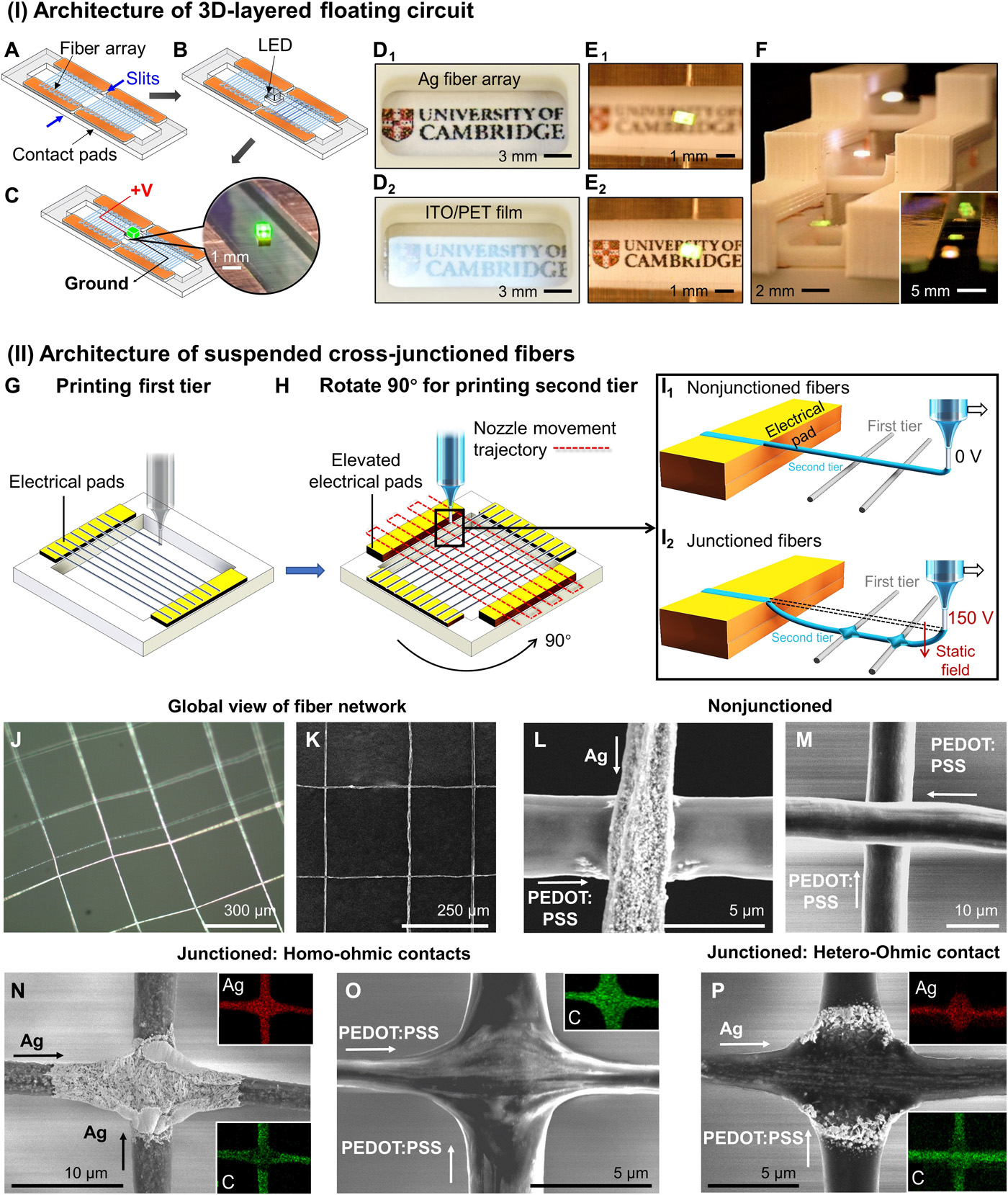Researchers from the University of Cambridge have developed a method for 3D printing tiny and transparent electronic fibers for a new generation of sensors. The fibers are 100 times thinner than a human hair and could be used to make devices capable of smelling, hearing and touching. The results were published in Science Advances.
In studying phenomena particularly relevant to the current COVID-19 pandemic, the report’s first author Andy Wang, a PhD from Cambridge’s Department of Engineering, sought to measure the amount of breath moisture that leaked through a face covering during normal breathing, rapid breathing and simulated coughing. To do so, Dr. Yan Yan Shery Huang, also from the Department of Engineering, led a team to 3D print composite fibers made from silver and/or semiconducting polymers.

This figure demonstrates the 3D printing of silver and PEDOT:PSS to create electronic fibers invisible to the human eye. Image courtesy of Science Advances.
The process developed by the researchers is a form of direct ink writing, in which silver) or a polymer called poly(3,4-ethylenedioxythiophene) polystyrene sulfonate (PEDOT:PSS) is deposited onto a copper contact pad, with an ion gun etching the fiber into the pad. The fibers are stretched between two copper pads, bridging the two electrodes.
To demonstrate the applications, the team created sensors for measuring moisture leaking through face coverings. The sensors were able to determine that the most leakage from fabric or surgical masks occurs from the front, particularly during coughing, while N95 masks leak most from the top and sides. All masks were determined to help weakened the flow of exhaled breath when worn properly.
“Sensors made from small conducting fibers are especially useful for volumetric sensing of fluid and gas in 3D, compared to conventional thin film techniques, but so far, it has been challenging to print and incorporate them into devices, and to manufacture them at scale,” Dr. Huang said. “Our fibre sensors are lightweight, cheap, small and easy to use, so they could potentially be turned into home-test devices to allow the general public to perform self-administered tests to get information about their environments.”
Uniquely, the sensors could be used to make non-contact, wearable, portable respiratory sensors that can be attached to a smartphone to collect breath patterns, as well as sound and images. The technology extends beyond respiratory sensors, with the team suggesting that biocompatible fibers with sizes similar to biological cells could allow them to guide cell movement and actually measure the process in the form of electrical signals.
Because the fibers are so small that they cannot be seen by the naked eye, the team was able to 3D print fibers for LED lights that seemed to float in the air. An LED was suspended from a transparent array made from silver fiber, as seen in the image above. Future work by the researchers includes multi-functional sensors for mobile health monitoring and bio-machine interfaces.
As detailed in our electronics 3D printing series, this is just one small bit of research that could eventually lead to the 3D printing of complete, functional objects in a single build process. At the moment, there are only a few commercial companies that provide the basis for such technology, including Optomec. What this research demonstrates is not only that 3D printing such complex devices is possible, but that this could advance the state of the art in such a way as to further shrink electronics.
Subscribe to Our Email Newsletter
Stay up-to-date on all the latest news from the 3D printing industry and receive information and offers from third party vendors.
You May Also Like
3D Printing Unpeeled: Wind Turbines, Probiotics and Lenses
TPI Composites, ORNL and Ingersoll Rand are working to make wind turbine tooling segments that can be 18.3 meters long. These elements also include resistive wires that help keep the...
3D Printing Unpeeled: Digital FDM Filament for Functional Gradients
Just published in Nature, a paper by a Seoul National University team looks at “3D printing with a 3D printed digital material filament for programming functional gradients.” Sang-Joon Ahn, Howon...
3D Printing Unpeeled: $5000 Cold Spray 3D Printer, Roland DGA & Living Materials
The AeroForge is a $5000 cold spray metal printer for copper made by a student team at Rice University. In a paper for ACS Central Science a team from Nanjing...
3D Printing Webinar and Event Roundup: April 28, 2024
In this week’s 3D Printing Webinar and Event Roundup, the Ceramics Expo is taking place in Michigan, Stratasys continues its advanced training courses, and SPE is holding a Polymer Characterization...
































